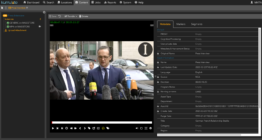Column: The effects of friction on workflow – UIs, loosely connected systems, application latency

Subscribe to NCS for the latest news, project case studies and product announcements in broadcast technology, creative design and engineering delivered to your inbox.
Regardless of the size or type of media organization, managing media workflows effectively is critical to your success. Content may need to move between different systems, formats, locations and users. Each of these moves can introduce friction into the workflow, slowing it down and sometimes even causing it to break down altogether.
If you imagine the different processes in your environment as the points on a map, a good workflow management system will act as the infrastructure that enables you to move your raw materials to the appropriate locales so that you can process them, store them, and eventually ship them off to where they need to go.
Not only does it provide a roadway that allows the materials to move freely, it also provides the bridges and tunnels that connect disparate areas that would otherwise be unable to work together. The better these roadways, bridges and tunnels are, the faster and more economically the materials will move.
Moving away from our metaphor into the real-world application of workflow management in media organizations, the most obvious barrier to efficient processes is the need to integrate different systems, in many cases from different vendors, so that they work together in a seamless fashion.
The rise of RESTful APIs and industry protocols has provided a better framework to put together these interfaces. But beyond the basics of the protocol and API documentation there is a need for a common understanding of the way each system works, and the content they can work with. For example, different systems may require different file formats or media wrappers. The workflow management system must not only be able to get content in and out of each system in the workflow, but also handle any transformations necessary to allow each systems to use the content.
In addition to smoothing out the bumps between systems, workflow management should also eliminate or reduce repetitive manual processes. Automating this type of “grunt work” fulfills two purposes. First, it frees users to devote their time to higher-value tasks that can’t be easily automated. Secondly, by automating tasks like renaming, transferring, and transcoding content, you remove the possibility of data entry errors that often plague the media chain.
As content moves between different systems and locations, the workflow management system must account for the latency in the various operations taking place. By using polling or notifications, the automated workflow can use content as soon as it’s available. Contrast this with manual workflows where users can get sidetracked by other tasks, creating bottlenecks that can affect the entire content chain.
The goal of workflow management should be to make processes as frictionless as possible. By breaking down the causes of friction in a media environment, we can define where automation can effect meaningful changes that increase the speed of tasks, eliminate errors and allow users to spend their time on creative pursuits instead of repetitive manual tasks.
View more columns in the Intelligent Storage Workflows series.
Subscribe to NCS for the latest news, project case studies and product announcements in broadcast technology, creative design and engineering delivered to your inbox.





tags
Broadcast Workflow, Content Distribution, Content Management Systems, Content Segmentation, Interoperable Master Format, ip workflow, MAM Workflow, Masstech, Media Asset Management, Metadata, Savva Mueller, workflow
categories
Broadcast Engineering, Broadcast Facility Technology, Content Delivery and Storage, Featured, IP Based Production, Media Asset Management, Voices